BROWN
Event: Synergy II
for Ensemble and Two Conductors
Score


Score

L E I P ZI G · L ONDO N · NE W YOR K
Earle Brown
For ensemble and two conductors Commissioned by Festival de Royan First performance conducted by Gilbert Amy and the composer.
Score (transposed)
Instrumentation
19 instruments ( 2 conductors)
2 Flutes
2 Oboes
1 English Horn
1 E Clarinet
2 B Clarinets
1 Bass Clarinet
2 Bassoons
4 Violins
2 Violas
2 Violoncelli
There are four other possible performance formats for one or two conductors:
1 . “A” Group alone: 10 instruments
1 Flute
1 Oboe
1 English Horn
1 B Clarinet
1 Bass Clarinet
1 Bassoon
2 Violins
1 Viola
1 Violoncello
2 . “B” group alone: 9 instruments
1 Flute
1 Oboe
1 E Carinet
1 B Clarinet
1 Bassoon
2 Violins
1 Viola
1 Violoncello
3 . “A” winds plus “B” winds: 11 instruments
2 Flutes
2 Oboes
1 English Horn
1 E Clarinet
2 B Clarinets
1 Bass Clarinet
2 Bassoons
4 . “A” strings plus “B” strings: 8 instruments
4 Violins
2 Violas
2 Violoncelli
Duration: variable
Each conductor needs an arrow indicator with numbers 1-4 (provided with score) to show the musicians which page to perform from.

Spontaneous decisions in the performance of a work and the possibility of the composed elements being “mobile” have been of primary interest to me for some time, the former to an extreme degree in FOLIO (1952) , and the latter, most explicitly, in TWENTY FIVE PAGES (1953) . The mobility of the elements was inspired by the mobiles of Alexander Calder, in which, similar to this work, there are basic units subject to innumerable different relationships or forms. The concept of the work being conducted and formed spontaneously in performance was originally inspired by the “action-painting” techniques and works of Jackson Pollock in the late 1940 s, in which the immediacy and directness of “contact” with the material is of great importance and produces such an intensity in the working and in the result. The performance conditions of these works are similar to a painter working spontaneously with a given palette. These comparisons are extremely dangerous and I emphasize that it is to the nature of the working process and the “mobility” of the formal possibilities that I refer, not to the quality or effect of the results.
One of the works in FOLIO is an “open-form,” “graphic” score called NOVEMBER 1952, subtitled SYNERGY . This score and DECEMBER 1952 are the two most extreme examples of performer determination from minimal scored information and represent an extreme point of “improvisation” which no longer interests me greatly. Since FOLIO ( 1952-53 ) my scores have been almost completely determined by myself as to sound-material content, despite the frequent case of the form being left “open.” SYNERGY , as I have worked with the concept, means the result of a collaborative process-relationship in the performance itself inherent in the score but not in detail foreseeable before the act of performing and perceiving.
In SYNERGY II I have increased the degree of control which the conductor may have over the individuals and groups within the orchestra and over-all form. Also, because of the opportunity of writing for the fine musicians of the Domaine Musical, I have increased the degree of self-determination of sound details by the musicians themselves in
approximately 50% of the score, but not to the exclusion of accuracy and responsibility to the precise scoring of many areas or the “graphic” scoring of trajectories and textures in other areas. It is a balance between the open-content, open-form SYNERGY of 1952 and the composed-content, open-form works such as AVAILABLE FORMS I and II.
I have felt that the conditions of spontaneity and mobility of elements with which I have been working create a more urgent and intense “communication” throughout the entire process, from composing to the final realization of a work. I prefer that each final form, which each performance necessarily produces, be a collaborative adventure, and that the work and its conditions of human involvement remain a living potential of engagement.
SCORE
Either conductor may begin a performance with any event on any page and may proceed from any page to any other page at any time, with or without repetitions or omissions of pages or events, remaining on any page or event as long as he wishes. Both conductors conduct simultaneously but independently. This independence is of course conditioned by the coexistence of the other group and, ultimately, is a collaborative and dependent process. It must be understood that this is one composition for essentially one group, a performance of which is the product of sympathetic musical collaboration between the two conductors in relation to the composed material and its formal potential.
The numbers of the score pages to be played from are indicated independently to the two groups by arrow indicators displaying numbers 1 to 4 – the numbers and arrows being clearly visible to all members of the groups, and comfortably within reach of the conductors. Each arrow indicator is intended to fit on an auxiliary music stand immediately in front of the podium, so that the part of the indicator bearing the large numbers faces the orchestra.
It is suggested that each podium be wide enough (or that enough music stands be used as a podium) for all four score pages to fit next to one another so as to be visible to each conductor at all times during the performance. (In the parts, all of the events on all of the pages are visible to the musicians without the necessity of page turns.)
There is a built-in factor of flexibility in the notation and scoring of this piece because the availability of forms is based on letting go of the idea of metric accuracy. This is achieved through the notational system used in this work. This system, which I have called a “time-notation,” is a development of the work in FOLIO ( 1952 and 1953 ) and most clearly represents sound-relationships in the score as I wish them to exist in performance independent of a strict pulse or metric system.
It is a “time-notation” (now generally called “proportional notation”) in that the performer’s relationship to the score, and the actual sound in performance, is realized in terms of the performer’s time-sense perception of the relationships defined by the score and not in terms of a rational metric system of additive units. The durations are extended visibly through their complete space-time of sounding and are precise relative to the space-time of the score. It is expected that the performers will observe as closely as possible the “apparent” relationships of sound and silence but act without hesitation on the basis of their perceptions.
It must be understood that the performance is not expected to be a precise translation of the spatial relationships but a relative and more spontaneous realization through the involvement of the performers’ subtly changing perceptions of the spatial relationships. The resulting flexibility and natural deviations from the precise indications in the score are acceptable and in fact integral to the nature of the work. The result is the accurate expression of the actions of people when accuracy is not demanded but “conditioned” as a function within a human process.
The conducting technique is basically one of cueing; the notation precludes the necessity and function of “beat” in the usual sense (although the conductor does indicate a tempo). The page which contains the event to be played is indicated by the arrow indicator, as previously explained. The number of the event to be performed is indicated by the left hand of the conductor – one to five fingers. A conventional (right-hand) down-beat initiates the activity. The relative speed and dynamic intensity with which an event is to be performed is implied by the speed and largeness of the down-beat as given with the right hand. Nearly all of the events in the score have been assigned dynamic values. These are acoustically accurate in terms of instrumental and ensemble sonority and balance and must be respected as written, although the conductor may “over-ride” the indicated dynamic values and raise or lower the over-all loudness.
The conception of the work is that the score presents specific material having different characteristics, and that this material is subject to many inherent modifications, such as modifications of combinations (event plus event), sequences, dynamics, and tempos, spontaneously created during the performance. All events are always prepared by a left-hand signal and initiated by a down-beat from the conductor; the size and rapidity of the down-beat implies the loudness and speed with which the event is to be performed. The conductors must, as with any notation, insist on accurately articulated relationships from the rhythmic “shape” of phrase and pitch sequences in this work.
GENERAL MODIFICATIONS OF EVENTS
CONDUCTED FERMATA : The conductor may introduce a fermata at any time during the performance, in any single event or combination of events. Both hands cupped towards the orchestra and held stationary indicates that all musicians in that group should hold the sound or silence which they are at that moment performing, until the next sign from the conductor tells them either to cut off or to continue from the point of interruption. A cut-off is signaled with both hands and must be followed by another eventsignal from the left hand and a down-beat. To continue, the conductor moves both hands from the “hold” position back to the body and then outward towards the orchestra, palms up (as giving the initiative back to the orchestra).
CONDUCTED STOP : The conductor may stop any event or combination of events at any time during the performance. The normal, two-hand cut-off signal will silence his entire group. Leaving the hands up with fists clenched will hold that silence until the signal to continue from the point of interruption is given. If the hands do not remain up in the “hold” position, the musicians are to expect another eventsignal from the left hand and a down-beat.
MODIFICATION OF SINGLE EVENT : Any two-hand cut-off signal by either conductor affects his entire group. The conductor may wish, however, to modify only one event among two or more events being performed simultaneously. To do this he
signals the number of the event to be modified with his left hand; then indicates the modification – a hold or cut-off –with only his right hand. (Events not indicated by the fingers of the conductor’s left hand continue to proceed normally.) It is absolutely essential that the orchestra members clearly understand this difference in signaling: a hold or cut-off by both hands affects the entire group; a hold or cut-off by only the right hand affects only the event indicated by the fingers of the left hand. Players whose parts do not contain events signaled by their conductor’s left hand must remain unaffected by his subsequent right-hand indications.
As soon as a conductor initiates (by left-hand event-signal and right-hand down-beat) a new event that appears on the player’s part, the preceding event is automatically cancelled. No specific stop-signal is required. The player simply discontinues the event he is playing and, without break between events, begins to play the new one.
With these procedures clearly understood by the conductors and the musicians it is possible to achieve smooth transitions and long lines of connected material of extreme complexity and frequent modification. The first impression derived from the score will be one of many sporadic fragments. This wealth of fragments shows the numerous formal possibilities inherent in the work, and it is this realization, not the fragmentations, that must become the dominant characteristic of the performance.
All indications of dynamics are relative to the instrumental technique and register of the particular sound called for, i.e., a string sound to be played col legno tratto, sul ponticello, with a dynamic of ffff, must be played as loudly as possible regardless of the dynamic intensity produced by the same dynamic marking in an instrument of a different nature. Thus, a low C in the flute marked as ffff is not expected to have the same volume as a middle-register tone marked ffff in a clarinet. This simply means that the flutist is to play his tones at the maximum volume available in that register of his instrument. The pppp indicates that the sound is to be
as soft as possible. All dynamic indications are “balanced” in this way, relative to their acoustic functions within the event-structures and the characteristics of the instrument employed in them.
This is a work for 19 instruments divided into two basic groups, the music for the groups being designated as A material and B material. “A material” is for six winds and four strings; “B material” is for five winds and four strings. The A and B designation does not mean that one set is more or less important than the other. The two materials are of equal importance within the work. It is an “open-form” work in proportional and graphic notations. The control of the form, the materials and the conducting techniques are basically the same as in my AVAILABLE FORMS I and II, FROM HERE, and MODULES I and II, etc.
There are five possible performance formats. I strongly suggest that the full 19 instruments be used, with two conductors, utilizing all A and B materials. (It is possible for one conductor, but I seriously suggest that two conductors be used; one for the A materials and one for the B materials.)
The following performance formats may also be used: ONLY the A materials: six winds and one string quartet. ONLY the B materials: five winds and one string quartet. ONLY the WIND materials of both A and B materials: 11 winds. ONLY the STRING materials of both A and B materials: two string quartets. In the latter four cases, one conductor is certainly sufficient but two may be used. (In these cases there will always be two different instrumental units, as scored.) There are four pages in each complete set of A material and B material, each of the four pages being a different kind of “activity,” notated differently for different degrees of compositional control and conductor-control.
In each set (A and B):
Pages 1 :
There are five events for winds and five for strings. The notation is highly specific as to pitch and dynamics; phrasing and duration are proportionally notated, as is the vertical relationship between instruments. (Each instrument sees its relationship to all others!)
These events must be very carefully rehearsed until performed extremely accurately as to content and shape. In performance they may be conducted in any sequence and in any superimposition of strings and winds. The tempo and overall loudness of each event may be varied each time it is performed, and may be called for by the conductor any number of times (see General Modifications of Events).
Page 2 :
WINDS : on personal cue to any one or more wind players the player is free to play any of the events that are between vertical dotted lines, in any sequence, until he is stopped by a personal cut-off by the conductor.
Or,
if more than one player is performing this material simultaneously a two-hand cut-off by the conductor indicates that all players stop! Conductors may cue any sequence and/or any number of players. Players should perform the events at the basic tempo that the conductor’s gesture suggests, and at the general loudness that is suggested, these latter to be controlled as in all events on all pages (see General Modifications of Events).
Page 2 :
STRINGS : this material is basically a graphically notated ensemble * string-quartet passage. The first time that this page is conducted in each performance it is to be performed by the string quartet as an ensemble Subsequently the conductor may give the cue for the material to be performed as an ensemble passage (as the first time the material is used) or he may give personal cues to individual members of the quartet who then perform their individual lines soloistically
*Accurate reproduction of vertical and horizontal relationships between the four instruments.
(the conductor may overlap the four solo lines to any degree). The same conductor-implications as to tempi and loudness apply as in all other cases.
Written instrumental techniques, the relative frequency trajectories, rhythmic spacings and dynamics must be respected at all times.
Pages 3:
There are five fermata chords each for the WINDS and STRINGS . They may be conducted (as indicated by the fingers of the left hand) in any sequence and at any speed that the musicians (with rehearsal) can comfortably follow and perform. The WINDS and STRINGS do not, of course, have to perform the same numbered chords at the same time. Each chord is held ( ) until the conductor either stops it or gives another chord for the musicians to move to. The conductor must always prepare the musicians for the chord he wishes with lefthand number indication and down-beat with right.
Pages 4:

On personal cue to any of the WIND or STRING players the player is free to perform any of the pitch material from anywhere on his page of material. The notated pitches and rhythms must be respected but the player may vary the instrumental techniques and dynamics as he wishes, based, however, on the tempo and loudness suggestions as cued by the conductor. The player may make the phrases (number of notes) in any one line as long as he wishes before moving vertically to another line of material. He may freely move about the page in this manner, playing sensitively in relation to others playing until cued to stop by the conductor or another page is indicated (and cued ) to be performed. (The material on page 4 is “statistical” and undesignated as to clef or instrumental registration. If one comes upon a pitch that is out of the range of one’s particular instrument, ignore that pitch and proceed with the others.)
Earle Brown
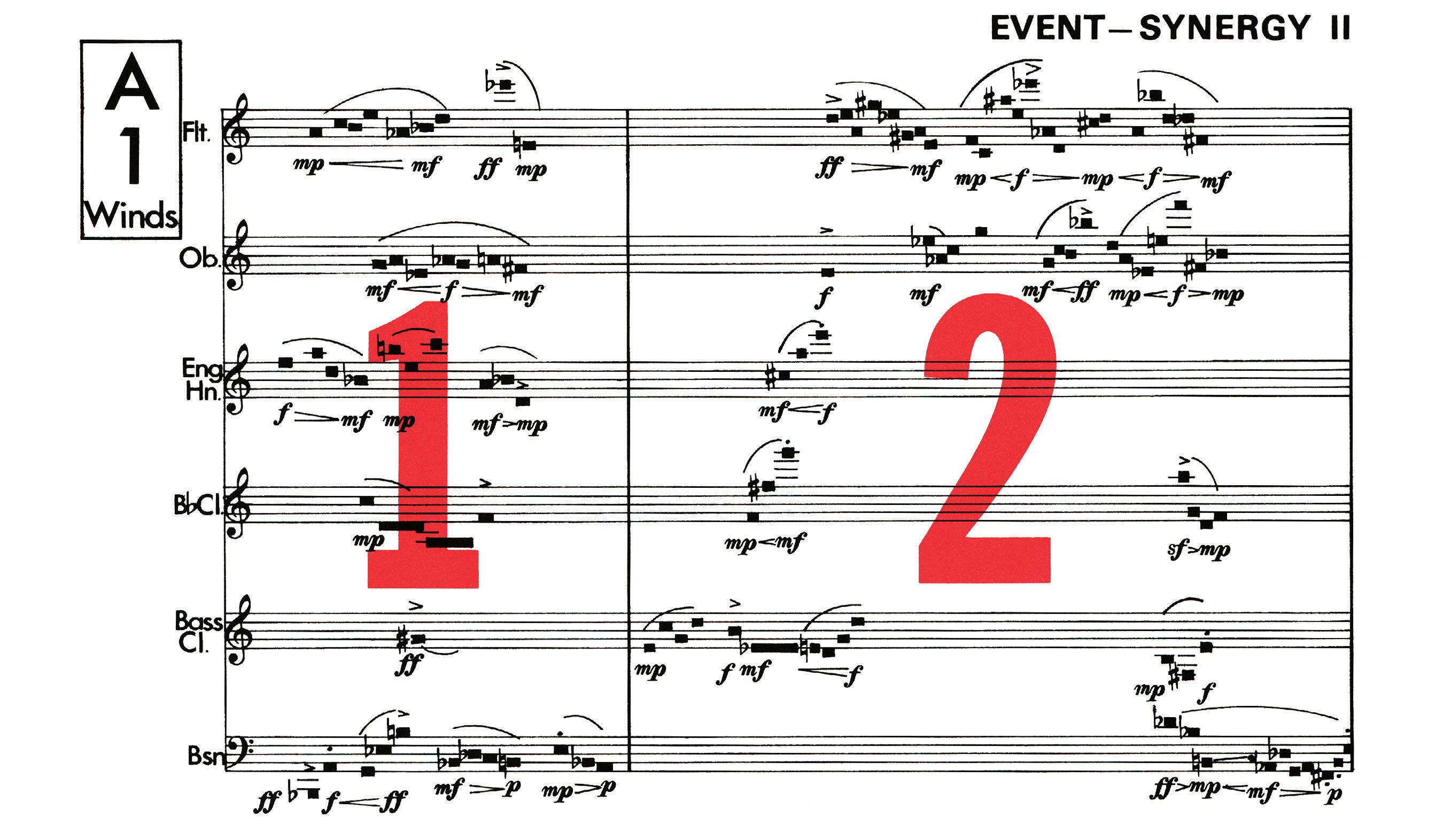

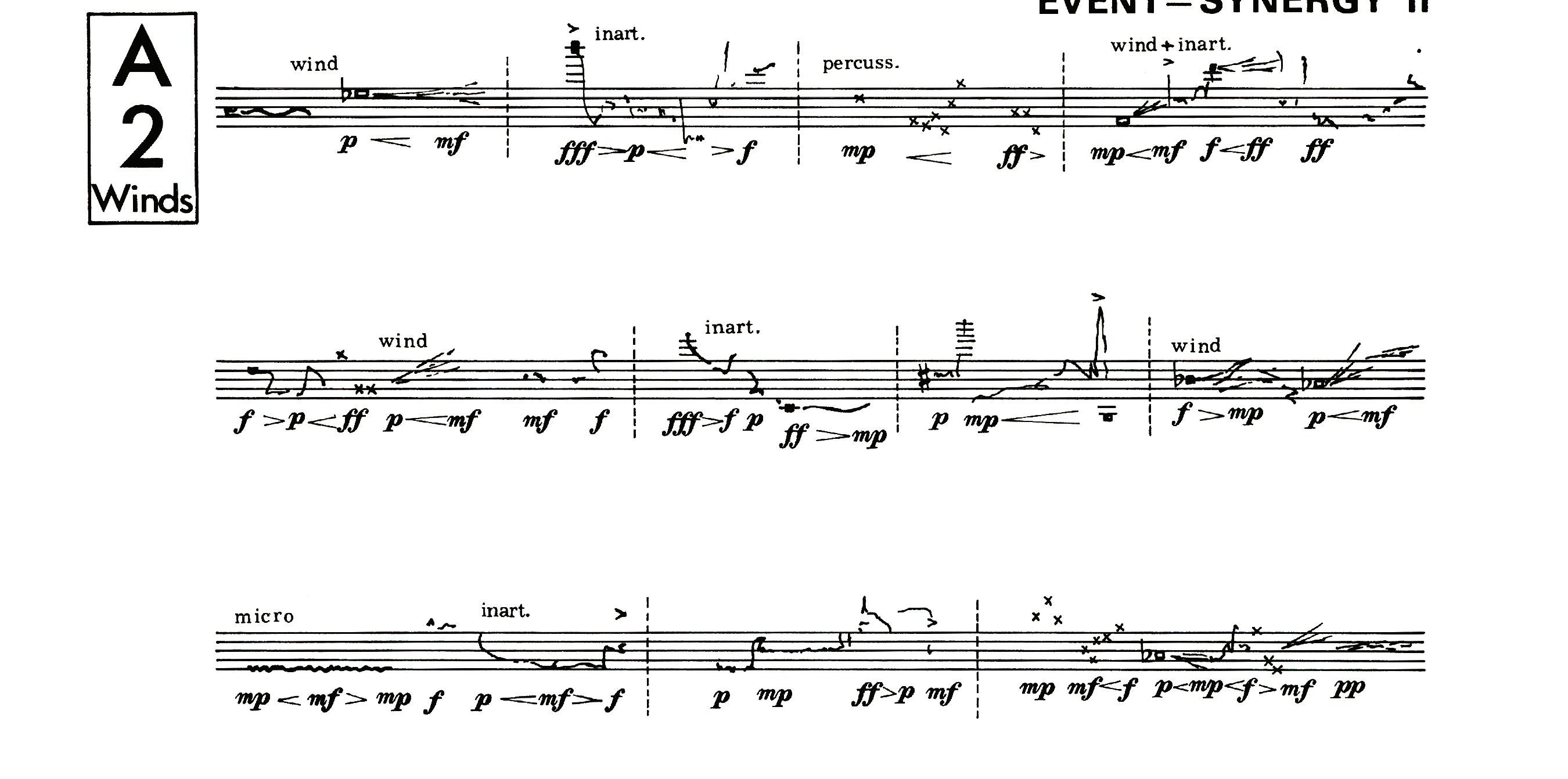
Page 1:
There are five events for winds and five for strings. The notation is highly specific as to pitch and dynamics; phrasing and duration are proportionally notated, as is the vertical relationship between instruments. (Each instrument sees its relationship to all others!) These events must be very carefully rehearsed until performed extremely accurately as to content and shape. In performance they may be conducted in any sequence and in any superimposition of strings and winds. The tempo and overall loudness of each event may be varied each time it is performed, and may be called for by the conductor any number of times (see General Modifications of Events).
Page 2:
Winds: on personal cue to any one or more wind players the player is free to play any of the events that are between vertical dotted lines, in any sequence, until he is stopped by a personal cut-off by the conductor.
Or,
if more than one player is performing this material simultaneously a two-hand cut-off by the conductor indicates that all players stop! Conductors may cue any sequence and/or any number of players. Players should perform the events at the basic tempo that the conductor’s gesture suggests, and at the general loudness that is suggested, these latter to be controlled as in all events on all pages (see General Modifications of Events).

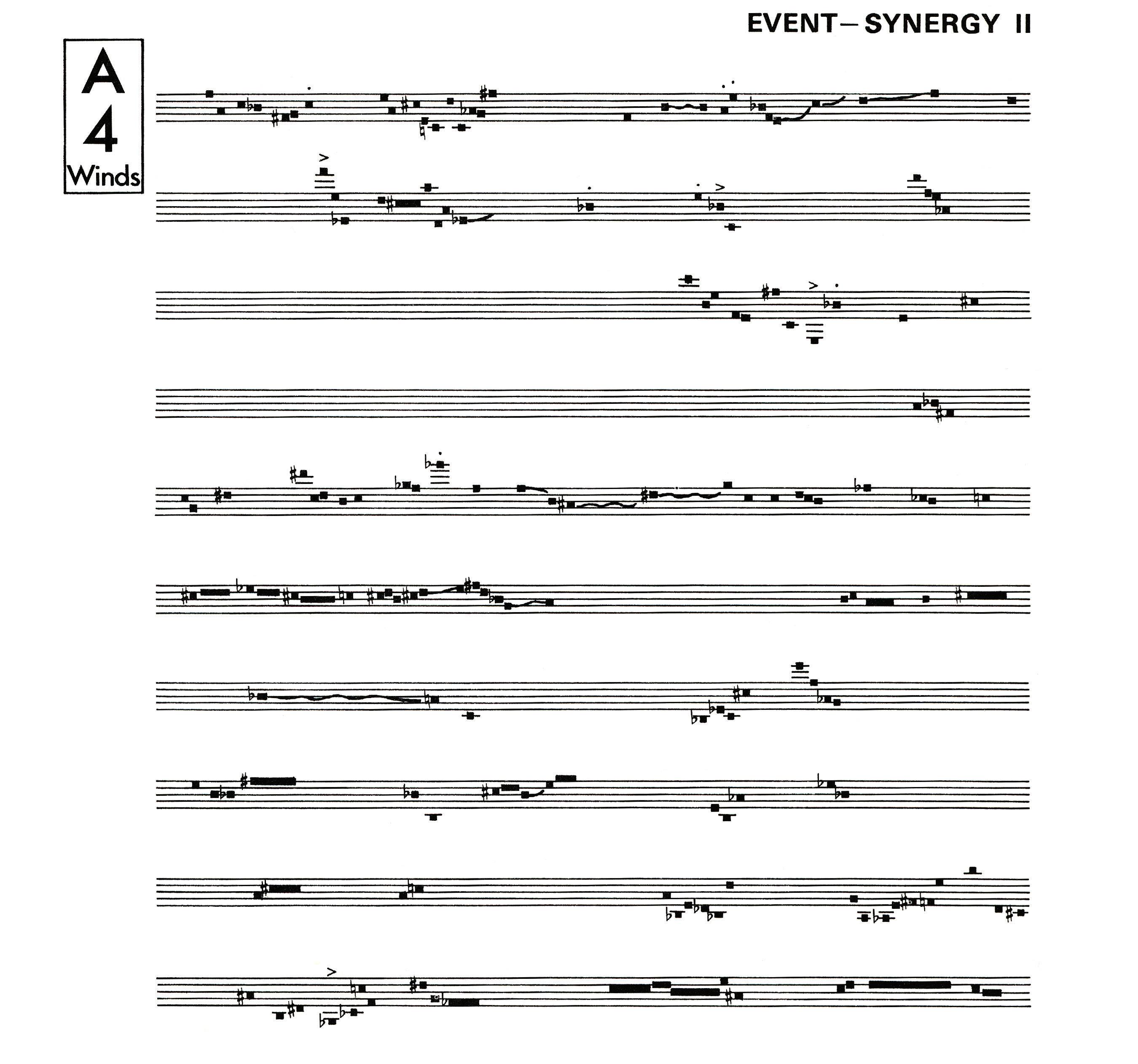
Page 3:
There are five fermata chords each for the winds and strings. They may be conducted (as indicated by the fingers of the left hand) in any sequence and at any speed that the musicians (with rehearsal) can comfortably follow and perform. The winds and strings do not, of course, have to perform the same numbered chords at the same time. Each chord is held ( ) until the conductor either stops it or gives another chord for the musicians to move to. The conductor must always prepare the musicians for the chord he wishes with left-hand number indication and down-beat with right.

Page 4:
On personal cue to any of the wind or string players the player is free to perform any of the pitch material from anywhere on his page of material. The notated pitches and rhythms must be respected but the player may vary the instrumental techniques and dynamics as he wishes, based, however, on the tempo and loudness suggestions as cued by the conductor. The player may make the phrases (number of notes) in any one line as long as he wishes before moving vertically to another line of material. He may freely move about the page in this manner, playing sensitively in relation to others playing until cued to stop by the conductor or another page is indicated (and cued ) to be performed. (The material on page 4 is “statistical” and undesignated as to clef or instrumental registration. If one comes upon a pitch which is out of range of one’s particular instrument, ignore that pitch and proceed with the others.)

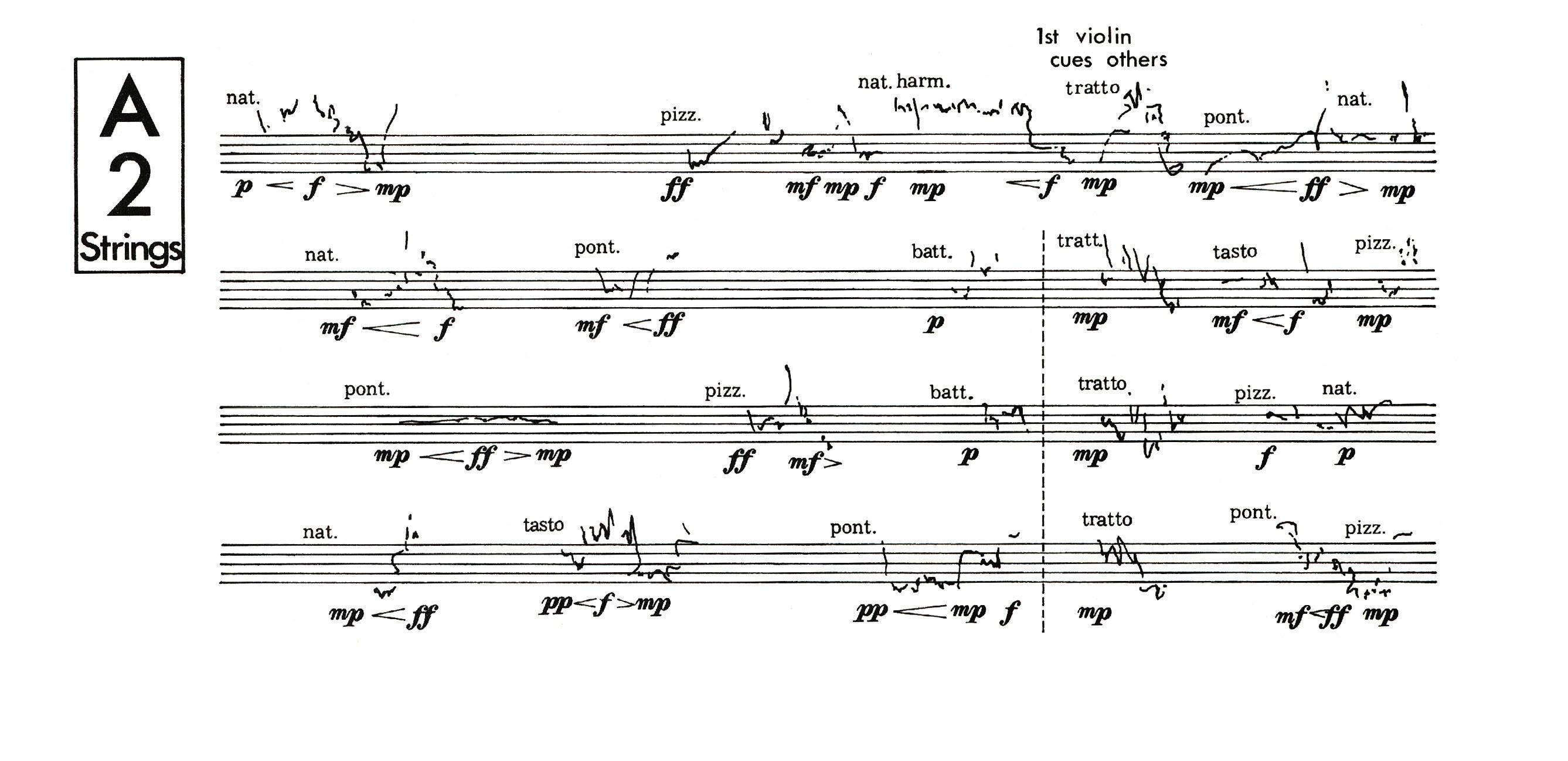
Page 1:
There are five events for winds and five for strings. The notation is highly specific as to pitch and dynamics; phrasing and duration are proportionally notated, as is the vertical relationship between instruments. (Each instrument sees its relationship to all others!)
These events must be very carefully rehearsed until performed extremely accurately as to content and shape. In performance they may be conducted in any sequence and in any superimposition of strings and winds. The tempo and overall loudness of each event may be varied each time it is performed, and may be called for by the conductor any number of times (see General Modifications of Events).
Page 2:
Strings: this material is basically a graphically notated ensemble* string quartet passage. The first time that this page is conducted in each performance it is to be performed by the string quartet as an ensemble
Subsequently the conductor may give the cue for the material to be performed as an ensemble passage (as the first time the material is used) or he may give personal cues to individual members of the quartet who then perform their individual lines soloistically (the conductor may overlap the four solo lines to any degree). The same conductorimplications as to tempi and loudness apply in all other cases.
Written instrumental techniques, the relative frequency trajectories, rhythmic spacings and dynamics must be respected at all times.
*Accurate reproduction of vertical and horizontal relationships between the four instruments.
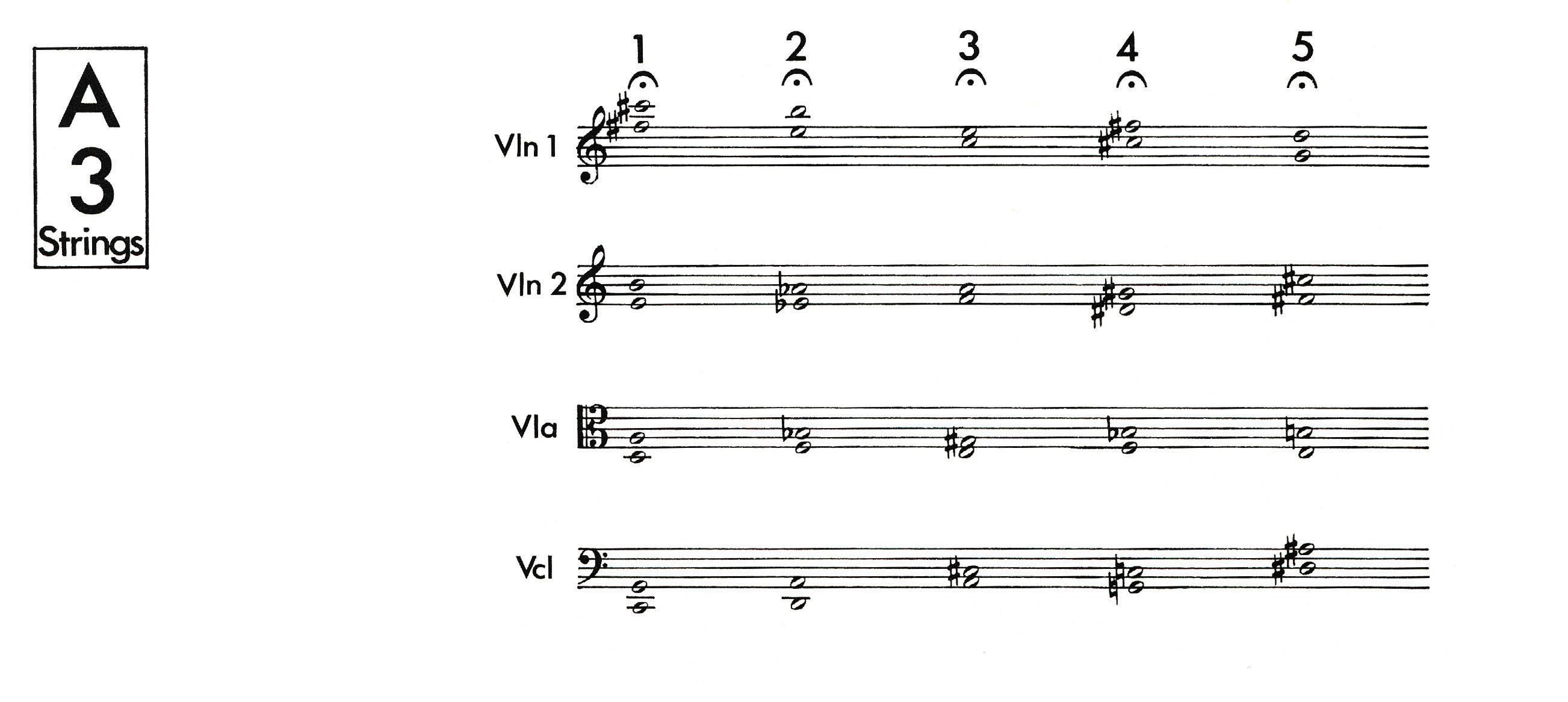
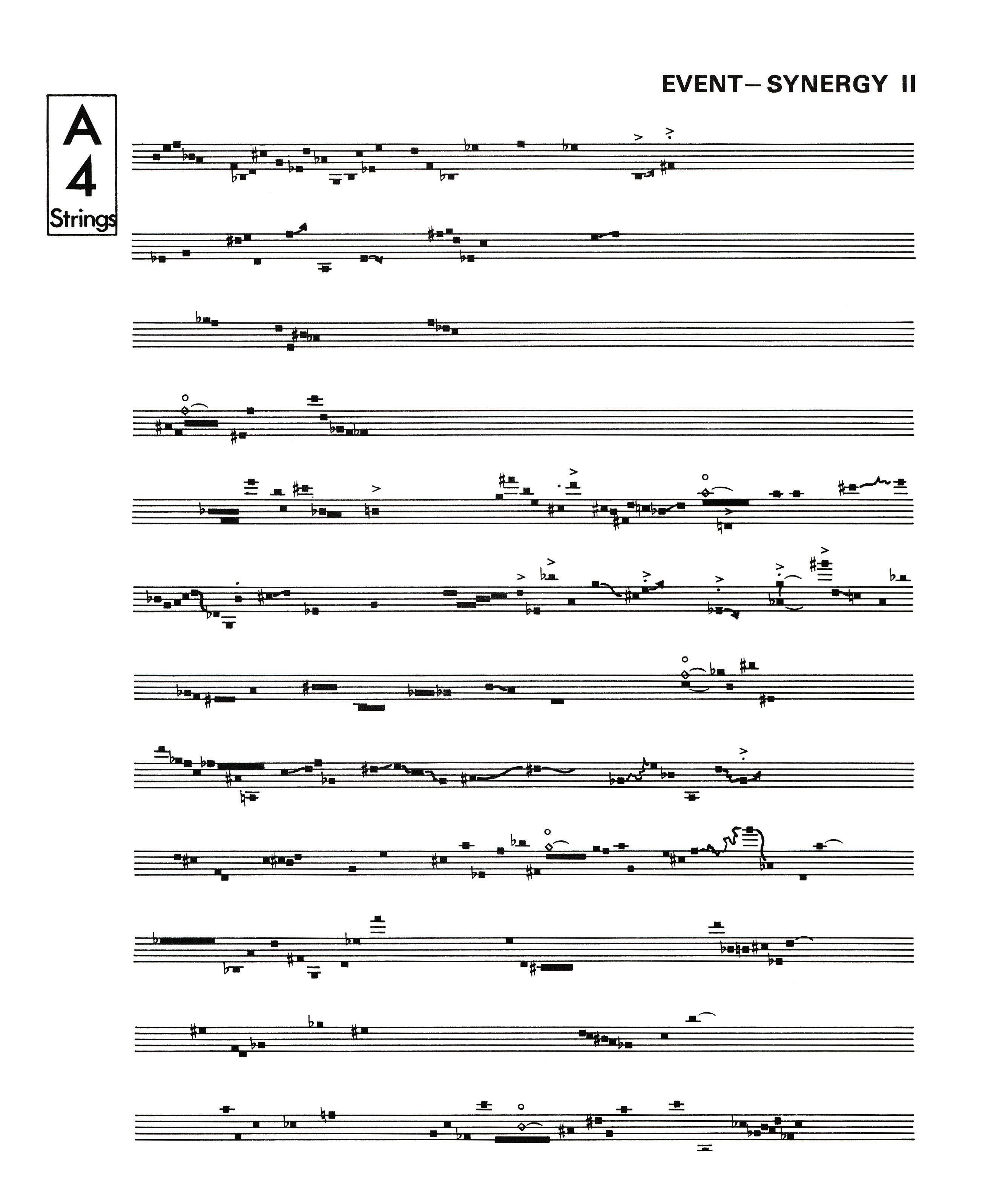
Page 3:
There are five fermata chords each for the winds and strings. They may be conducted (as indicated by the fingers of the left hand) in any sequence and at any speed that the musicians (with rehearsal) can comfortably follow and perform. The winds and strings do not, of course, have to perform the same numbered chords at the same time. Each chord is held ( ) until the conductor either stops it or gives another chord for the musicians to move to. The conductor must always prepare the musicians for the chord he wishes with left-hand number indication and down-beat with right.

Page 4:
On personal cue to any of the wind or string players the player is free to perform any of the pitch material from anywhere on his page of material. The notated pitches and rhythms must be respected but the player may vary the instrumental techniques and dynamics as he wishes, based, however, on the tempo and loudness suggestions as cued by the conductor. The player may make the phrases (number of notes) in any one line as long as he wishes before moving vertically to another line of material. He may freely move about the page in this manner, playing sensitively in relation to others playing until cued to stop by the conductor or another page is indicated (and cued ) to be performed. (The material on page 4 is “statistical” and undesignated as to clef or instrumental registration. If one comes upon a pitch which is out of range of one’s particular instrument, ignore that pitch and proceed with the others.)


Page 1:
There are five events for winds and five for strings. The notation is highly specific as to pitch and dynamics; phrasing and duration are proportionally notated, as is the vertical relationship between instruments. (Each instrument sees its relationship to all others!) These events must be very carefully rehearsed until performed extremely accurately as to content and shape. In performance they may be conducted in any sequence and in any superimposition of strings and winds. The tempo and overall loudness of each event may be varied each time it is performed, and may be called for by the conductor any number of times (see General Modifications of Events).
Page 2:
Winds: on personal cue to any one or more wind players the player is free to play any of the events that are between vertical dotted lines, in any sequence, until he is stopped by a personal cut-off by the conductor.
Or
if more than one player is performing this material simultaneously a two-hand cut-off by the conductor indicates that all players stop! Conductors may cue any sequence and/or any number of players. Players should perform the events at the basic tempo that the conductor’s gesture suggests, and at the general loudness that is suggested, these latter to be controlled as in all events on all pages (see General Modifications of Events).


Page 3:
There are five fermata chords each for the winds and strings They may be conducted (as indicated by the fingers of the left hand) in any sequence and at any speed that the musicians (with rehearsal) can comfortably follow and perform. The winds and strings do not, of course, have to perform the same numbered chords at the same time. Each chord is held ( ) until the conductor either stops it or gives another chord for the musicians to move to. Conductor must always prepare the musicians for the chord he wishes with left-hand number indication and down-beat with right.

Page 4:
On personal cue to any of the wind or string players the player is free to perform any of the pitch material from anywhere on his page of material. The notated pitches and rhythms must be respected but the player may vary the instrumental techniques and dynamics as he wishes, based, however, on the tempo and loudness suggestions as cued by the conductor. The player may make the phrases (number of notes) in any one line as long as he wishes before moving vertically to another line of material. He may freely move about the page in this manner, playing sensitively in relation to others playing until cued to stop by the conductor or another page is indicated (and cued ) to be performed. (The material on page 4 is “statistical” and undesignated as to clef or instrumental registration. If one comes upon a pitch which is out of range of one’s particular instrument, ignore that pitch and proceed with the others.)
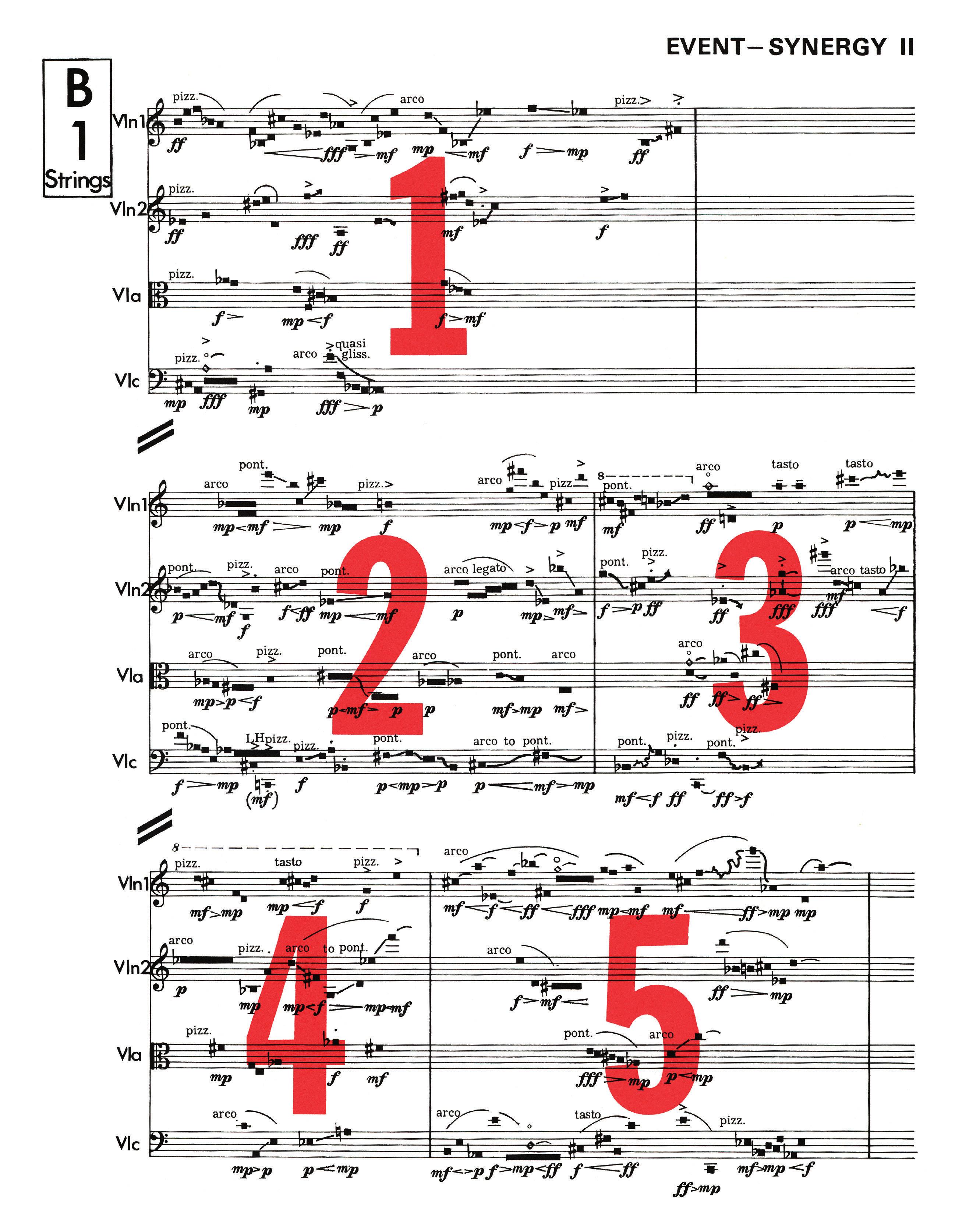
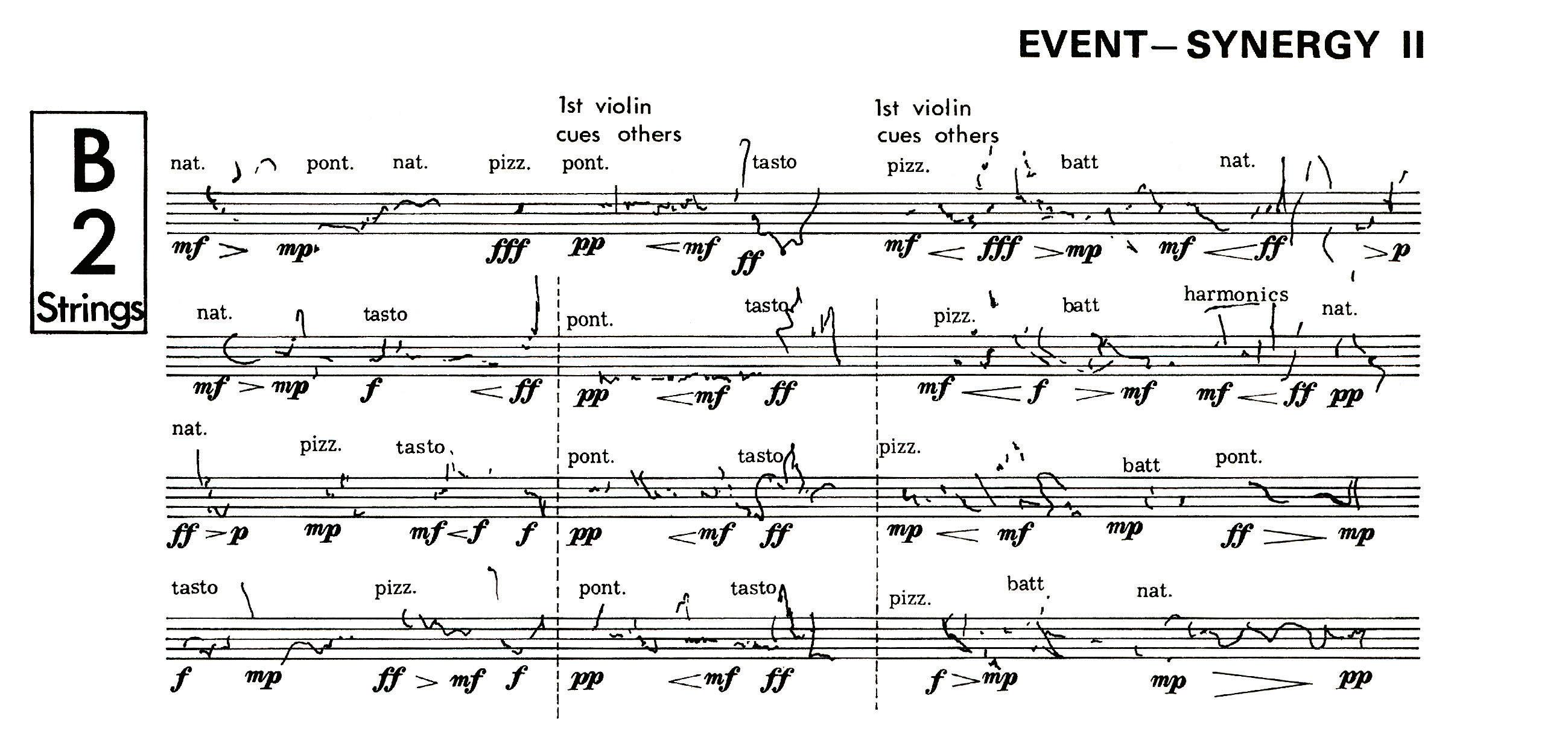
Page 1:
There are five events for winds and five for strings. The notation is highly specific as to pitch and dynamics; phrasing and duration are proportionally notated, as is the vertical relationship between instruments. (Each instrument sees its relationship to all others!) These events must be very carefully rehearsed until performed extremely accurately as to content and shape. In performance they may be conducted in any sequence and in any superimposition of strings and winds. The tempo and overall loudness of each event may be varied each time it is performed, and may be called for by the conductor any number of times (see General Modifications of Events).
Page 2:
Strings: this material is basically a graphically notated ensemble* string quartet passage. The first time that this page is conducted in each performance it is to be performed by the string quartet as an ensemble Subsequently the conductor may give the cue for the material to be performed as an ensemble passage (as the first time the material is used) or he may give personal cues to individual members of the quartet who then perform their individual lines soloistically (the conductor may overlap the four solo lines to any degree). The same conductorimplications as to tempi and loudness apply in all other cases.
Written instrumental techniques, the relative frequency trajectories, rhythmic spacings and dynamics must be respected at all times.
*Accurate reproduction of vertical and horizontal relationships between the four instruments.
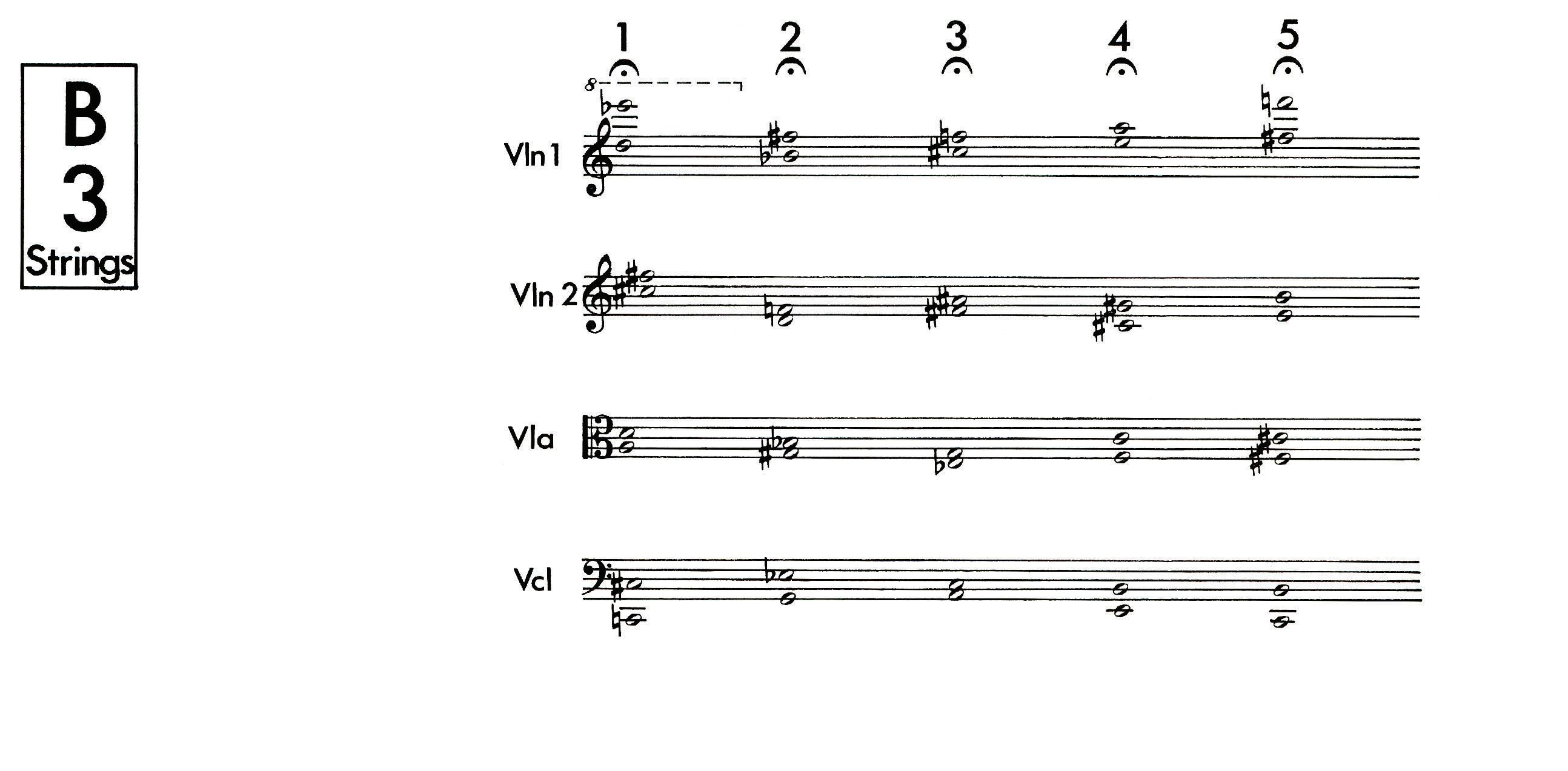

Page 3:
There are five fermata chords each for the winds and strings. They may be conducted (as indicated by the fingers of the left hand) in any sequence and at any speed that the musicians (with rehearsal) can comfortably follow and perform. The winds and strings do not, of course, have to perform the same numbered chords at the same time. Each chord is held ( ) until the conductor either stops it or gives another chord for the musicians to move to. The conductor must always prepare the musicians for the chord he wishes with left-hand number indication and down-beat with right.

Page 4:
On personal cue to any of the wind or string players the player is free to perform any of the pitch material from anywhere on his page of material. The notated pitches and rhythms must be respected but the player may vary the instrumental techniques and dynamics as he wishes, based, however, on the tempo and loudness suggestions as cued by the conductor. The player may make the phrases (number of notes) in any one line as long as he wishes before moving vertically to another line of material. He may freely move about the page in this manner, playing sensitively in relation to others playing until cued to stop by the conductor or another page is indicated (and cued ) to be performed. (The material on page 4 is “statistical” and undesignated as to clef or instrumental registration. If one comes upon a pitch which is out of range of one’s particular instrument, ignore that pitch and proceed with the others.)
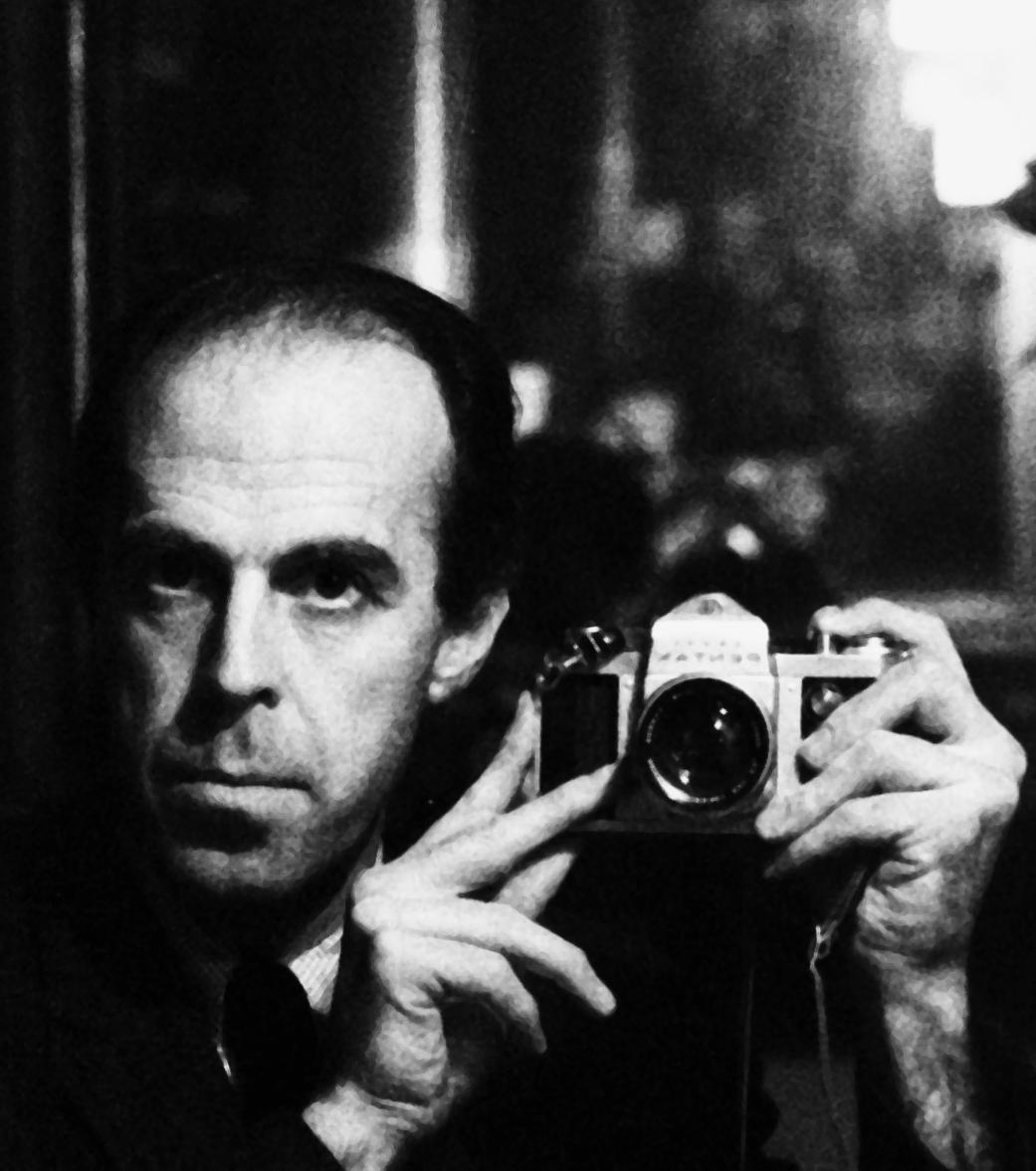
Earle Brown was born in 1926 in Lunenburg, Massachusetts, and in spirit remained a New Englander throughout his life. A major force in contemporary music and a leading composer of the American avantgarde since the 1950s, he was associated with the experimental composers John Cage, Morton Feldman and Christian Wolff, who – together with Brown – came to be known as members of the New York School. Brown died in 2002 at his home in Rye, New York.
Earle Brown wurde 1926 in Lunenburg, Massachusetts, geboren und blieb im Geist ein Leben lang Neuengländer. Ab den 1950er Jahren war er eine treibende Kraft in der zeitgenössischen Musik und einer der führenden Komponisten der amerikanischen Avantgarde. Enge Verbindung unterhielt er zu den experimentellen Komponisten John Cage, Morton Feldman und Christian Wolff, mit denen gemeinsam er später der sogenannten New York School zugerechnet wurde. Brown starb 2002 in seinem Haus in Rye, New York.